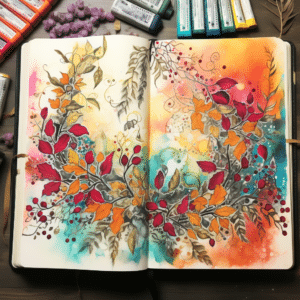
Bible journaling: Bible journaling is an artistic and personal way to experience scripture. If you’re new to it, here’s some help to begin!
- Choose a journal that fits your style. Traditional or specialized – plenty of space for your thoughts and art.
- Gather supplies: pens, colored pencils, watercolors, and anything else that inspires. Experiment to find what works best.
- Read the passage thoroughly. Think about its meaning and message. Identify key verses that are special to you.
- Unleash your creativity! Illustrate the words with colors, drawings, hand-lettering, or collage. Allow your imagination to make beautiful visuals.
- Include written reflections with the art. Prayers, thoughts, and questions inspired by the passage. Deepen your understanding and connection.
- Establish a routine. Make time each day or week to focus without distractions. Treat it as a sacred time.
A final tip: Bible journaling is your personal journey. There’s no wrong way – just let your creativity flow as you connect with the divine.
What is Bible journaling?
Bible journaling is a fun way to mix art and writing for a deeper reflection on scripture. Pick a bible verse and use art supplies like colored pencils, markers, or watercolors to create visuals that represent the scripture. Add decorations like stickers or washi tape! Plus, make notes, prayers, or reflections to personalize it. It’s a one-of-a-kind journey to connect with God’s Word. Enjoy combining creativity with your faith!
Benefits of Bible journaling for beginners

Bible journaling is a great way for beginners to start their spiritual journey! It allows individuals to explore God’s word in a creative and personal way. Here are some of the benefits:
- Creativity: Use colors, drawings, and lettering to express thoughts and insights.
- Reflection: Take time to write or draw verses to understand God’s message.
- Memory Retention: Engaging in artistic expression while studying helps reinforce learning and aids in long-term memory.
Journaling can also give you a sense of belonging to a group. Share your work with other believers to inspire them and start talks about faith.
Plus, it has a long past. Back hundreds of years, monks would make decorated and illustrated books called “illuminated manuscripts.” These works of art were both ways to pray and keep the Bible’s stories alive.
In conclusion, Bible lets people who are new to the Bible get involved with it through creativity, thought, and building community. As people grow, they can learn more about their spirituality and leave behind important art for future generations.
Getting started with Bible journaling
- Gather the basics: Collect necessary supplies such as a journal, coloured pens/pencils and art materials.
- Select a Bible verse: Find a passage that is meaningful to you. This will be the base of your journaling.
- Meditate: Read and think about the verse. Consider its meaning and how it applies to you. Let this guide your creativity.
- Get Inspired: Look for inspiration from devotionals, art, or nature. These may help with ideas for illustrations or themes related to the verse.
- Express yourself: Put the verse on paper with your art skills. Try out lettering styles, doodles and illustrations to capture the message.
- Accept Imperfections: Bible journaling is a personal expression of faith, not a competition. Concentrate on expressing your heart and connecting with God through the process.
- Find your own style: Discover different techniques, experiment with new materials and make your creativity flourish authentically. Pro Tip: Set aside time for Bible journaling regularly to develop consistency and deepen your relationship with scripture via art.
Basic tips for beginners
Find a journaling Bible with wide margins for your creative expressions. Get colored pencils, pens, stickers and more to bring your illustrations to life. Don’t be afraid to experiment with different techniques and styles that reflect your personal interpretation.
Set aside time each day or week to engage in Bible journaling. Start small and build from there. Personalize it with colors, fonts, images, quotes and prayers. Choose verses based on personal reflection. Bible journaling is an artistic and spiritual practice to deepen your relationship with God. So, start today and watch your faith come alive!
Advanced tips for taking Bible journaling to the next level
Take your Bible journaling to the next level! Here are some tips to get you started:
- Use mixed media – experiment with watercolors, acrylic paints, colored pencils, and markers.
- Incorporate hand lettering – learn various lettering styles and fonts to create visually appealing headings and quotes.
- Explore different layouts – try out grids, collages, and themed spreads.
- Include meaningful elements – add washi tapes, stickers, die-cuts, or ephemera.
To further enrich your Bible journaling practice:
- Create interactive elements – add flaps, pockets, or fold-outs.
- Experiment with textures – use fabric scraps, tissue papers, thread, or natural elements.
- Explore typography – play with fonts and calligraphy styles.
- Incorporate multimedia features – use QR codes and audio recordings.
Don’t miss out! Take your journaling experience to the next level by exploring new techniques and materials. Enjoy a deeper connection with God’s Word through your creative expression. Get started today!
Journaling prompts for beginners
Set aside time each day to write and connect with God. Bible journaling is a personal expression of faith – experiment with styles, colors, art and writing formats. Keep an open mind, be vulnerable and embrace the process.
Prompts to consider:
- Reflect on a Bible verse that has impacted your life and why it is significant.
- Write about a difficult situation and how faith helped you overcome it.
- Explore the deeper meaning of a word or phrase from the Bible.
- Jot down lessons from a sermon or devotional.
- Describe a goal or area of growth and find biblical passages for guidance.
- Create a prayer journal and reflect on how God has answered them.
Overcoming common challenges in Bible journaling
Since my friend wanted to learn more about the Bible, they started Bible writing. At first, they had trouble picking the right materials, getting ideas, and not being afraid to make mistakes. It’s important to remember that Bible journaling is unique and that there is no one right way to show faith. When you accept your flaws, you can create beautiful art. We can strengthen our spiritual connections through creative expression if we have a good attitude and are kind. The journey of my friend was motivating. Their growth and change were amazing.
Sharing your Bible journaling journey

Share your journey! Join forums or attend local meetups. Take advantage of learning from experienced Bible journalers, ask questions, and get feedback. Make meaningful connections with beginners and pros.
Also, join a Bible journaling group or club. Here, workshops or classes are led by experienced artists. Learn new techniques in a supportive environment. Make friends and collaborate on projects.
Pro Tip: Don’t stay in your comfort zone. Try new things in your journaling journey. Try different art supplies, styles, and interpretations of Scripture. This will help you grow as an artist and deepen your understanding of the Word of God.
Conclusion
Sum it up: Bible is a great way to connect with scriptures and be creative. By using art, colors, and reflections, you can understand the Bible better and make a meaningful keepsake.
A few tips before you start:
| 1. Get a notebook or journal that suits your preferences and let your creativity flow. Check if you want lined or blank pages, and if the paper’s good for art. |
| 2. Collect supplies like pens, pencils, paints, stamps, and stickers. Try different techniques and find what you like. There are no strict rules in Bible journaling – let your imagination run wild! |
| 3. Pick meaningful passages and read their context. Represent them with illustrations or typography. |
| 4. Reflect on the messages and how they relate to your life. Use it for self-reflection and spiritual growth. Write thoughts and prayers too. |
| 5. Dedicate time for Bible journaling. Make it a habit and engage with scripture. Do it daily or weekly. |
Pro Tip: Don’t worry about comparing yourself to others or striving for perfection. Embrace imperfections and enjoy the process. Happy journaling!
Frequently Asked Questions
Q: What is Bible journaling?
A: Bible journaling is the creative practice of using art, writing, and other tools to engage with Scripture. It allows individuals to personalize their Bible by adding illustrations, notes, and reflections directly onto the pages.
Q: How do I start Bible journaling?
A: To start Bible writing, get a Bible with wide margins that is made for that purpose, or use a notebook along with your regular Bible. Choose art materials like markers, colored pencils, or watercolor paints. Start by choosing a verse or piece to focus on. Then, use the text to inspire art or writing.
Q: What supplies are essential for Bible journaling?
A: You need a Bible or a notebook, pens or markers that won’t bleed through the pages, colored pencils or watercolor paints, glue to stick cutouts or photos on, and any other art items or tools you like, like stencils or stamps.
Q: How should I select a Bible verse or passage for journaling?
A: Pick a Bible quote or passage that speaks to you or fits with where you are in life right now. It could be a phrase you like or one that makes you think. Think about which verses are important to you and let that guide your choice for your journal.
Q: What are some techniques for Bible journaling?
A: There are many ways to write in a notebook, such as hand-lettering, coloring pictures, making collages, using washi tape or stickers, adding extra pages with tip-ins or flip-outs, and doodling. Try out different methods until you find the one you like best.
Q: Can I make mistakes in my Bible journaling?
A: Absolutely! Writing in a diary is a personal and creative process, and making mistakes is part of the way. Accept your flaws as chances to learn and grow. Remember that the point of Bible writing is not to be perfect, but to learn more about and feel closer to the Bible.






